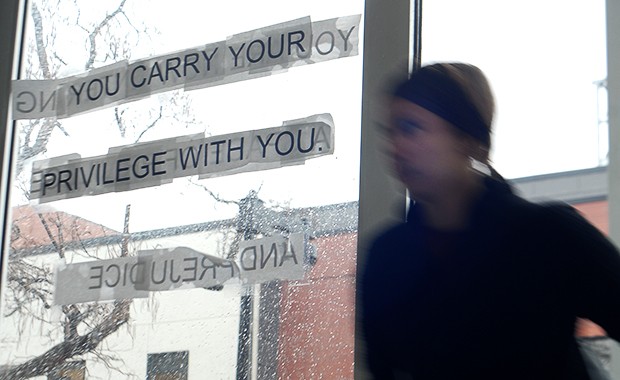Until last week, a letter taped to the glass windows in the University of MinnesotaâÄôs Barbara Barker Center for Dance greeted visitors with a declaration of protest. The letter, along with other photographs, articles and quotes, is part of âÄúTHIS,âÄù an ongoing protest at the dance center by anonymous students who said they feel institutional racism is a problem in the program. The protest, which has been going on since mid-February, began with a few photos and quotes posted in a stairwell, and has escalated to a full statement of protest and postings all around the dance center. The protest included an open letter to the dance department that stated the UniversityâÄôs faculty has failed to create an atmosphere free from prejudice. It is unknown how many students are actually involved in the protest. The protestors, who wish to remain anonymous, said they wanted to raise awareness of racial issues in the program and plan to continue protesting in a direct, but nonviolent way. The protestors would only respond via e-mail to protect anonymity. There has been little exposure University-wide about the protest, but recently, several meetings were held by the dance department to address the issue. The casting of Missa Brevis , a production in the dance program, has been acknowledged by faculty, staff and students as a catalyst of the protest. During the casting two students of color were not selected, but felt that they should have been, said Ananya Chatterjea, professor and director in the UniversityâÄôs dance program. Chatterjea said the students felt it was because of their race. Despite the protest, Chatterjea said she feels the department promotes diversity. âÄúIn our department, we have gone out of our way to make sure we are not only casting blonde, blue-eyed dancers, which has been the ideal of the dance world outside,âÄù she said. Chatterjea said she believes the UniversityâÄôs program is one of the most progressive she has seen. Of the eight faculty members in the UniversityâÄôs dance department, four are faculty of color, Chatterjea said. But protesters said the casting was only one example of many mishandled discussions. Thus far, the faculty and staff at the dance center have not removed the protestersâÄô signs. However, some people have taken down the posters and added their own signs to oppose the original protest. Erin McIntire, a first-year student of color, posted a series of responses, titled âÄúTHAT.âÄù A sign McIntire posted read, âÄúTHAT is a protest to the passive aggressive behavior of âÄòTHISâÄô toward the faculty and staff of the University of Minnesota Dance program, regardless of âÄòcolorâÄô or race.âÄù But the protest has been getting support from other student groups. Chardae Kimber, a junior and member of the Black Motivated Women student group , received and e-mail from âÄúTHISâÄù informing the group of an upcoming meeting to address the protest. She said she feels issues of racial discrimination need to be addressed. âÄúI think there is a lack of faculty encouragement when it comes to students of color,âÄù she said. Carl Flink, director of the UniversityâÄôs theater arts program, said he hopes to meet with the student protestors and have an open discussion on how to address their concerns. To come up with a solution for the concerns, Flink also said the department plans on working with the Office of the Vice President and Vice Provost for Equity and Diversity .

Image by Marija Majerle
A student walks past a statement of protest Monday in the Barbara Barker Center for Dance. The statement is part of “THIS,” a more than month long protest by anonymous students who feel institutional racism is an existing problem in the dance program.
Students protest racial issues in dance program
The anonymous protesters have been putting up posters and sending e-mails.
Published March 23, 2009
0

